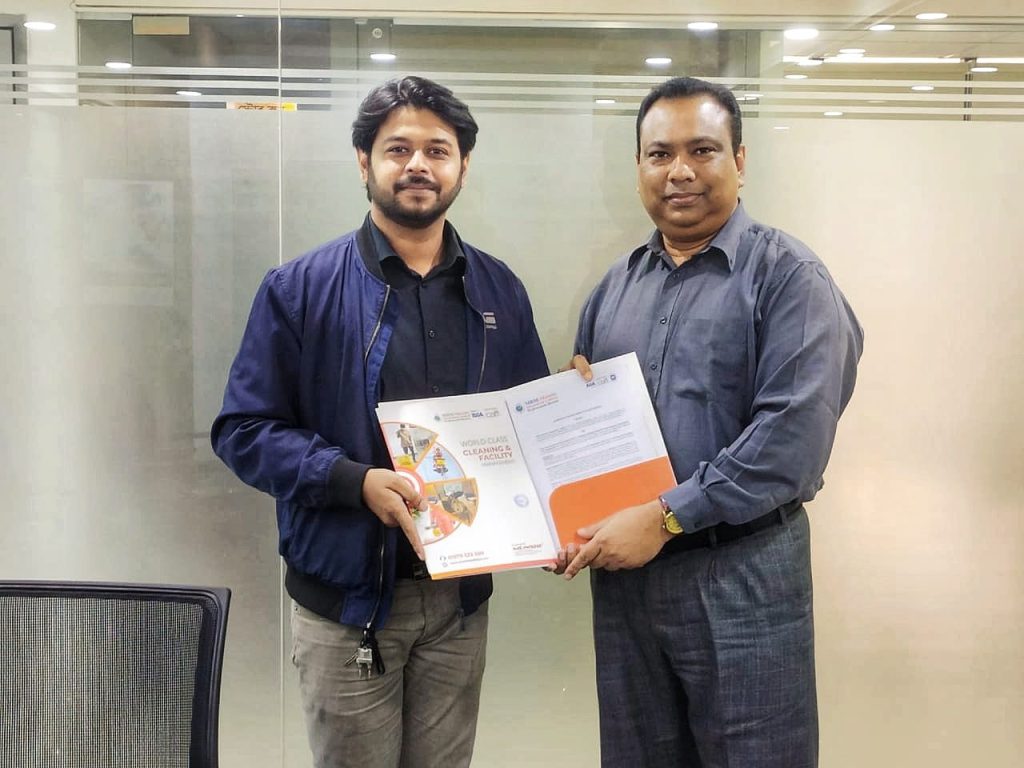Md. Asadul Islam Anik
Assistant Manager, Sales & Business Development
MBM-Munshi Bangladesh Ltd
Md. Asadul Islam Anik is a dynamic professional serving as the Assistant Manager of Sales and Business Development at MBM-Munshi Bangladesh Ltd. With a passion for driving growth and excellence, Anik brings a wealth of knowledge and expertise to the team. His strategic thinking, dedication, and innovative approach make him a valuable asset in the ever-evolving landscape of sales and business development. Anik is committed to delivering results and fostering lasting relationships, making him a key player in MBM-Munshi Bangladesh Ltd.’s continued success.
Let’s learn about his journey.
The InCAP: Md. Asadul Islam Anik, can you please provide an overview of your current role as Assistant Manager in Sales & Business Development at MBM-Munshi Bangladesh Ltd? What are your key responsibilities and achievements in this position?
Md. Asadul Islam Anik: MBM-Munshi is Bangladesh’s leading provider of commercial cleaning services. In MBM-Munshi Bangladesh Ltd my current role is Assistant Manager in Sales & Business Development Department and in this role, I would likely involve assisting in the development of sales strategies to promote the company’s services and increase revenue. Forging strategic partnerships or alliances with other businesses or organizations that can lead to mutual growth and expanded service offerings.
Here are some of my key responsibilities:
- Client Acquisition: I would be in charge of discovering and prospecting potential facilities management clients. This includes prospect research, initial contact, and presenting the company’s offerings. Discover and develop fresh sales prospects with companies, event organizers, and civic groups.
- Market Analysis: Discovering opportunities and threats in the facilities management business by analyzing market trends, competition activity, and consumer feedback. This data can be used to improve sales techniques and remain ahead of the competition.
- Proposal and Contract Development: Creating proposals and contracts that are carefully tailored to the demands of the client. This could include negotiating pricing, setting service standards, and ensuring all legal and contractual duties are met.
- Sales Team Support: Providing support and guidance to the sales team, including training and coaching junior salespeople, creating targets, and reviewing their performance. Reporting: Reporting includes preparing frequent reports on sales operations, revenue estimates, and market insights for senior management to review. These reports can aid in decision-making and strategy modifications.
- Compliance and Continuous Improvement: Involves ensuring that all sales and business development operations follow company policies, industry regulations, and ethical standards. Identifying areas for process improvement within the sales and business development department and striving to increase efficiency and effectiveness.
- Networking: Building and maintaining a network of industry contacts and potential clients. This could involve attending industry events, conferences, and trade shows.
- Customer Feedback and Satisfaction: To continually raise customer satisfaction, the organization collects client input and incorporates it into its services and business strategies.
Achievements: Since joining MBM-Munshi Bangladesh Ltd, I have acquired over 20 companies to increase growth and revenue, including the ICT Division of the Bangladesh Government, the Export Promotion Bureau (a Bangladesh government agency), the Bangladesh Tennis Federation, Sun Pharmaceuticals Ltd, Pharma Solutions BD Ltd, East West University, and the Daily Bonik Barta, STS Group. I extended 27 contracts for new and existing clients while maintaining a high level of customer satisfaction, allowing me to reduce client retention from 17% to 5%. Another achievement is working with International Convention City Bashundhara by providing 700+ manpower for an event support.
Sales and business development often require a proactive approach to identifying new opportunities. Can you share an example of a successful initiative or strategy you implemented that significantly contributed to the growth of your team or the company?
Yes! I concur with this. Finding new prospects frequently calls for a proactive strategy in sales and business development. To enhance our sales and business development efforts for specific high-value accounts, I established an Account-Based Marketing (ABM) strategy at MBM-Munshi Bangladesh Ltd.
Multi-Channel Approach: To reach decision-makers within the target accounts, I used a multi-channel approach that included email marketing, social media, tailored direct mail, and targeted web advertising.
Aligning Sales and Marketing: I made sure that our marketing and sales teams at MBM-Munshi worked closely together. We ought to hold regular meetings to assess their performance, exchange ideas, and improve their strategy.
Identifying High-Value Accounts: The Sales and Business Development teams collaborated to develop a list of high-potential target accounts. These were the businesses with the greatest potential for revenue development.
MBM-Musnhi’s ABM strategy resulted in considerable growth in sales and business development. We witnessed increased conversion rates by tailoring their pitch because our messaging clearly addressed the pain points of our target accounts. Because we were better positioned to supply solutions that matched the individual demands of each account, the personalized approach resulted in greater transaction sizes. Customers valued the individualized approach, which increased overall customer satisfaction and resulted in referrals and repeat business. As a result of this strategy, we saw tremendous revenue growth, cementing our position as a leader in the Facility Management market. That is how I have used ABM strategy to help increase MBM-Munshi’s sales and business development efforts, especially in the highly competitive technology sector.

In your role, you likely interact with a variety of clients and customers. How do you build and maintain strong client relationships? Can you share a specific example where your relationship-building skills played a pivotal role in securing a deal or partnership?
To create or strengthen a solid client relationship, I need to learn about the clients’ problem points. Since the beginning of my work, I have always followed this rule by providing solutions that actually satisfy my client’s needs, even if it means recommending products or services that are not part of my portfolio. Developing and sustaining good customer connections is crucial for long-term success and business growth as a corporate sales specialist. Here are some critical techniques and best practices for excelling in this role:
Knowledge About Client’s Business: Spend time learning about the client’s industry, difficulties, and goals, as well as researching their rivals and market trends to provide valuable insights.
Be a Trusted Advisor: Build trust by consistently delivering on promises and commitments.
Effective Communication: Communicate concisely and clearly with clients, and actively listen to them to grasp their goals and issues. Also, be available to them for questions and concerns.
Personalize Approach: I should tailor their approach to each client’s individual wants and preferences, and they should genuinely care about their success.
Continuous Learning: Stay updated on industry trends, competitive offerings, and sales techniques.
Regular Follow-Ups and be proactive: Maintain regular contact with clients, not only when it want to make a sale, and check in on the development of the solutions I’ve provided and solicit feedback. Anticipate client needs and give solutions before they ask, and keep them up to date on new products, services, or features that may be of interest to them.
In 2017 I worked with Rangs Motors Ltd (Rangs Group) and won a tender for 7 units of commercial vehicles at Bangladesh Sugar and Food Industry Corporation. In the whole process of govt tenders, I have maintained a very effective and professional relationship with top to bottom employees of that organization. Without continuous learning of communications skills and an understanding of client business, this will be very hard to secure this deal with BSFIC.
Mr. Anik, Sales and business development can be highly competitive. How do you stay updated with industry trends and competitive intelligence to ensure you’re ahead of the curve? Can you describe a recent instance where this knowledge gave you an advantage in your work?
To keep a competitive edge, sales and business development professionals must stay current on market trends and competitive information.
As a sales and business development professional, I set aside time each week to conduct research and study. Subscribe to relevant blogs, newsletters, and journals, and attend webinars or conferences to stay up to date on industry news. Expand knowledge by taking online courses and using online resources. Keep an eye on competitors on a regular basis. Look at their products, prices, marketing techniques, and consumer feedback. Examine what distinguishes them and identify places where I may differentiate our offerings. Attend industry events, join associations, and use platforms like LinkedIn to network with peers and thought leaders. Discussions with individuals in my profession can bring useful insights. Pay attention to what my customers have to say. Gather feedback through surveys, interviews, and interactions with customer service. Customer insights frequently identify developing trends and opportunities for development. Regularly perform a SWOT analysis (Strengths, Weaknesses, Opportunities, Threats) for your company and competitors. This exercise can uncover areas to exploit and potential pitfalls.
Example: Staying current on industry trends and competitive intelligence recently gave me a huge advantage in my career as a business development specialist. In the sector, I noticed a trend showing that customers were becoming increasingly worried about the environmental impact of the products they purchased. New rules and shifting consumer expectations for sustainable products were driving this movement.
With this information, I collaborated closely with our product development team to build a more sustainable version of one of our signature goods. Pest control is a very sensitive issue and we promote it with authentic certification. We also changed our marketing brochures to emphasize the product’s environmentally friendly qualities. We stressed our dedication to sustainability when approaching potential clients, connecting our presentation with their beliefs and the industry trend. Our ability to adapt to the evolving industry landscape gave us a clear advantage over competitors who were slower to respond to the trend.

Metrics and data analysis are important aspects of assessing performance in sales and business development. What key performance indicators (KPIs) do you track regularly, and how do you use this data to inform your strategies and decision-making?
KPIs are critical for monitoring and overseeing the performance of your sales and business development teams. They can tell you how well your strategies are functioning and where you may make changes. Here are some key performance indicators to monitor on a regular basis for analyzing sales and business development performance:
- Sales Revenue or Manpower Deployment
- Sales Conversion Rate
- Gross Margin
- Customer Retention Rate
- Lead Generation Metrics
- Follow-up or market visit rate
By checking these KPIs on a regular basis, I can readily determine my current performance and the next step I should take. In my industry, sales income or personnel deployment can draw my attention to a sales target. As we all know, when you work in the sales department, you will be assigned a sales target. The sales conversion rate is the percentage of leads or prospects who convert into paying customers, which allows me to move further with those clients who have yet to convert by calling or meeting with them. Customer Retention Rate is the percentage of customers who continue to conduct business with our company over time and can show me the client’s priority level. The percentage of income that remains after deducting the cost of products sold is known as the gross margin. It denotes financial success. After determining the gross margin, if it is lower than I expected, I must increase sales in order to make up the difference.
These KPIs provide an in-depth look at my sales and business development performance. Monitoring and evaluating these indicators on a regular basis can help me make more informed decisions, optimize tactics, and drive growth in my company.
Md. Asadul Islam Anik, Adaptability is vital in a dynamic field like sales and business development. Can you share an example of a situation where you needed to pivot your approach due to unexpected changes or challenges in the market? How did you adapt, and what were the results?
As an Assistant Manager in the Sales and Business Development department, I was responsible for three executives who visited the market to conduct market research and produce new leads. We provide facility management services such as regular cleaning, deep cleaning, water tank cleaning, event support service, and so on. These services were well-received by the market, and the sales team was able to close a number of deals in the first few months of this year. However, after roughly 6 months, the market became saturated, and the sales staff was having difficulty closing deals. Then I recognized that in order to continue to be successful, I needed to change my approach. I made the decision to concentrate on selling the service to a new market sector, namely pest control. I also chose to alter the sales team’s compensation such that they were rewarded for selling pest control services.
My pivot was a success. The sales team was able to close more agreements, which raised the company’s revenue. I was able to adjust to shifting market conditions and maintain my success.
Here are some particular steps I took to change my approach:
- I conducted pest control market research and determined the demands of this market sector.
- I developed a sales pitch tailored to the needs of a pest control service.
- I taught my team members how to sell to pest control companies.
- I gave my sales crew bonuses for selling pest control services.
- I constantly encourage and empower them to achieve their goals.
I was able to pivot my strategy and remain effective in the face of changing market conditions by taking these measures.
What specific qualities or characteristics do we think our professional icons possess that make them successful or influential?
Professional icons frequently have a combination of qualities and attributes that contribute to their success and influence. While these characteristics vary based on the individual and field, the following are some typical characteristics linked with successful and prominent professionals. Professional symbols are often well-versed and skilled in their particular industries. They are always investing in their education and growth in order to remain at the forefront of their field. They have a genuine enthusiasm for their work, which leads them to continually put in the time and effort required to thrive. Their commitment is unshakeable. Many icons are well-known for their capacity to think creatively and create. They are dissatisfied with the current quo and are looking for new and better ways to do things. Icons frequently have excellent leadership abilities, whether they are leading teams, organizations, or industry revolutions. They motivate and inspire others to follow in their footsteps. Maintaining strong ethical standards is critical for long-term success and influence. In terms of ethical behavior, icons are frequently viewed as role models. They have a clear and compelling vision for the future that they can explain in a way that motivates others to join them in their endeavors. Influential professionals have the ability to adapt to changing situations, technologies, and market conditions. They are not dogmatic in their approach, but rather adaptable.
We should remember that, while these characteristics are shared by successful and important professionals, each person’s path is unique, and the particular combination of traits that leads to success can vary greatly.

Quick Chat With Md. Asadul Islam Anik
The most outstanding achievement of your life as of now:
Completing Masters from University of Dhaka
The greatest philosopher in your view:
Aristotle
Your Icon:
My father, He is a businessman
Name the most influential books you have read:
Think and Grow Rich by Napoleon Hill
Your greatest fear:
Not meeting project deadlines or failing to deliver on client expectations.
Best piece of advice you’ve received:
Don’t grab other people’s fruits
You in only three words:
Confident, Enthusiast and Quick Learner
Skill Set
Hard Skills: Product and Industry Knowledge, Lead Generation, Communication Skills, Presentation Skills, Negotiation Skills, Data Analysis, Microsoft Office Skills (Technical) and Time Management Skills.
Soft Skills: Adaptability, Corporate Etiquette Skills, Corporate Politics Skills, Effective Email Approaching Skills, Managing Superior Skills, Emotional Intelligence Skills, Work-Life Balance Skills and Positive Attitude.

Prayer For The Human Civilization:
Pray for the world to be prosperous and widespread, with enough for everyone to meet their basic needs.
The InCAP: Thank you, Mr. Anik! It’s a glittering conversation with you!
Md. Asadul Islam Anik: My pleasure! Wish you all the best! Thank you
To read more about Professional Icon’s stories, Please Click Here!







